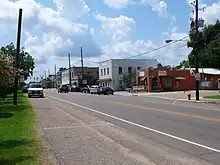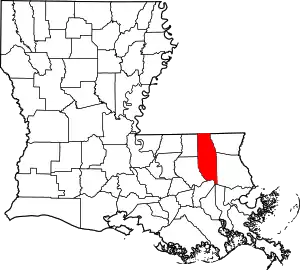Independence, Louisiana
Independence, originally known as Uncle Sam,[4] is a town in Tangipahoa Parish, Louisiana, United States. The population was 1,665 at the 2010 census. It is part of the Hammond Micropolitan Statistical Area.
Independence, Louisiana | |
|---|---|
| Town of Independence | |
 Location of Independence in Tangipahoa Parish, Louisiana. | |
.svg.png.webp) Location of Louisiana in the United States | |
| Coordinates: 30°38′07″N 90°30′14″W | |
| Country | United States |
| State | Louisiana |
| Parish | Tangipahoa |
| Government | |
| • Mayor | Jim Paine |
| Area | |
| • Total | 2.41 sq mi (6.25 km2) |
| • Land | 2.41 sq mi (6.24 km2) |
| • Water | 0.00 sq mi (0.00 km2) |
| Elevation | 82 ft (25 m) |
| Population (2020) | |
| • Total | 1,635 |
| • Density | 678.14/sq mi (261.86/km2) |
| Time zone | UTC-6 (CST) |
| • Summer (DST) | UTC-5 (CDT) |
| ZIP code | 70792[3] |
| Area code | 985 |
| FIPS code | 22-37025 |
| GNIS feature ID | 2405882[2] |
History
The move to establish Independence as a town was led in the early 20th century by State Representative Harry D. Wilson, who subsequently served from 1916 until his death early in 1948 as the Louisiana Commissioner of Agriculture and Forestry. Wilson was a son of Dr. and Mrs. William D. Wilson. In 1856, Dr. Wilson had built a store in Independence, which remained for years the oldest building in the community. Harry Wilson worked in the parish seat of Amite in the general store of the merchant Jacob Stern at a time when Tangipahoa Parish did not yet depend on the strawberry crop.[5] During the 1890s, Wilson was an express messenger for the Illinois Central Railroad.[6] He left that position to pursue a political career.
Affectionately known by voters as "Uncle Harry" or "Mister Harry", Wilson served two nonconsecutive terms in the state House from 1900 to 1904 and again from 1908 to 1912.[7] A strong promoter of his hometown of Independence, located five miles to the south of Amite, Wilson in 1902 and 1903 corresponded with Governor William Wright Heard regarding incorporation of the community, which at the time had a population of 308. Governor Heard informed Wilson that he considered the three square miles proposed for the new town as too much land for a small village and suggested that the tract be reduced in size. Originally named "Uncle Sam", Independence had begun in 1852 when the New Orleans, Jackson and Great Northern Railroad began operating through the area. Independence was finally proclaimed a town on August 22, 1912.[6]
Geography
Independence is located at 30°38′7″N 90°30′14″W (30.635293, -90.504005).[8]
According to the United States Census Bureau, the town has a total area of 2.2 square miles (5.7 km2), all land.
Demographics
| Census | Pop. | Note | %± |
|---|---|---|---|
| 1880 | 68 | — | |
| 1910 | 1,004 | — | |
| 1920 | 1,032 | 2.8% | |
| 1930 | 1,700 | 64.7% | |
| 1940 | 1,498 | −11.9% | |
| 1950 | 1,606 | 7.2% | |
| 1960 | 1,941 | 20.9% | |
| 1970 | 1,770 | −8.8% | |
| 1980 | 1,684 | −4.9% | |
| 1990 | 1,632 | −3.1% | |
| 2000 | 1,724 | 5.6% | |
| 2010 | 1,665 | −3.4% | |
| 2020 | 1,635 | −1.8% | |
| U.S. Decennial Census[9] | |||
2020 census
| Race | Number | Percentage |
|---|---|---|
| White (non-Hispanic) | 732 | 44.77% |
| Black or African American (non-Hispanic) | 768 | 46.97% |
| Native American | 3 | 0.18% |
| Asian | 8 | 0.49% |
| Other/Mixed | 48 | 2.94% |
| Hispanic or Latino | 76 | 4.65% |
As of the 2020 United States census, there were 1,635 people, 711 households, and 492 families residing in the town.
2010 census
As of the census[11] of 2010, there were 1,665 people, 663 households, and 446 families residing in the town. The population density was 772.4 inhabitants per square mile (298.2/km2). There were 735 housing units at an average density of 329.3 per square mile (127.1/km2). The racial makeup of the town was 54.59% White (of which Italian-Americans make up 30.7% of the population ), 40.24% African American, 0.66% Native American, 1.62% Asian, 0.42% from other races, and 2.46% from two or more races. Hispanic or Latino of any race were 4.38% of the population.
There were 663 households, out of which 31.2% had children under the age of 18 living with them, 42.1% were married couples living together, 21.9% had a female householder with no husband present, and 32.7% were non-families. 28.1% of all households were made up of individuals, and 15.2% had someone living alone who was 65 years of age or older. The average household size was 2.60 and the average family size was 3.21.
In the town, the population was spread out, with 28.7% under the age of 18, 9.3% from 18 to 24, 25.5% from 25 to 44, 19.7% from 45 to 64, and 16.9% who were 65 years of age or older. The median age was 35 years. For every 100 females, there were 85.4 males. For every 100 females age 18 and over, there were 78.0 males.
The median income for a household in the town was $22,446, and the median income for a family was $30,685. Males had a median income of $28,125 versus $17,105 for females. The per capita income for the town was $10,495. About 20.8% of families and 29.3% of the population were below the poverty line, including 42.3% of those under age 18 and 24.0% of those age 65 or over.
Education
Tangipahoa Parish School Board operates public schools:
- Independence High Magnet School
- Independence Leadership Academy
Arts and culture
Independence has a large Italian-American community, as do neighboring towns and villages.[12] Independence has a Sicilian heritage festival every year the second weekend in March. Independence has sometimes been referred to colloquially as Little Italy, and Italian expatriates began settling here as early as the 19th Century.[13]
Many attributes of the Italian culture, including food, in Independence are described in Italian Culture in Independence.[14] Other useful resources are Southeastern Louisiana University's Center for Regional Studies[15] and the Tangipahoa Parish tourist information center.[16]

Notable people
- Nick Bruno, President of the University of Louisiana at Monroe
- Robert Crais, best-selling novelist
- Steven Jyles, a Canadian Football League quarterback
- Frank Lockett, former NFL wide receiver for the Miami Dolphins
- Carl Marshall, Southern Soul Singer
- Clif Richardson, former state representative
- LaBrandon Toefield, former LSU star runningback and NFL runningback for the Jacksonville Jaguars and Carolina Panthers
References
- "2020 U.S. Gazetteer Files". United States Census Bureau. Retrieved March 20, 2022.
- U.S. Geological Survey Geographic Names Information System: Independence, Louisiana
- "Independence ZIP Code". zipdatamaps.com. 2022. Retrieved November 30, 2022.
- John V. Baiamonte Jr., "Italians in Louisiana" in LLA Bulletin, Volume 57 Number 1, Summer 1994; Harry P. Becnel, "Customs, Traditions, and Folklore of a Rural Southern Italian-American Community" in Folklife in the Florida Parishes, edited by Joel R. Gardner (Baton Rouge: Louisiana Division of the Arts, Office of Cultural Development, Department of Culture, Recreation, and Tourism, 1989).
- "Early History and Families of Amite". familytreemaker.genealogy.com. Retrieved May 1, 2013.
- "Independence, Tangipahoa Parish, Louisiana". files.usgwarchives.net. Retrieved May 1, 2013.
- "Membership in the Louisiana House of Representatives 1812-2012". Historical membership of the Louisiana House of Representatives. Retrieved May 1, 2013.
- "US Gazetteer files: 2010, 2000, and 1990". United States Census Bureau. February 12, 2011. Retrieved April 23, 2011.
- "Census of Population and Housing". Census.gov. Retrieved June 4, 2015.
- "Explore Census Data". data.census.gov. Retrieved December 28, 2021.
- "U.S. Census website". United States Census Bureau. Retrieved January 31, 2008.
- See especially Tickfaw, Louisiana, which is located four miles to the south of Independence.
- Louisiana Department of Culture, Recreation and Tourism. "Independence Louisiana Historical Marker".
- Italian Culture in Independence Archived 2009-06-19 at the Wayback Machine is an online scholarly pamphlet offered by the University of New Orleans. It cites other published sources.
- "Center For Southeast Louisiana Studies". www.selu.edu. Retrieved April 16, 2016.
- "Welcome to Tangipahoa Parish!". www.tangi-cvb.org. Retrieved April 16, 2016.
